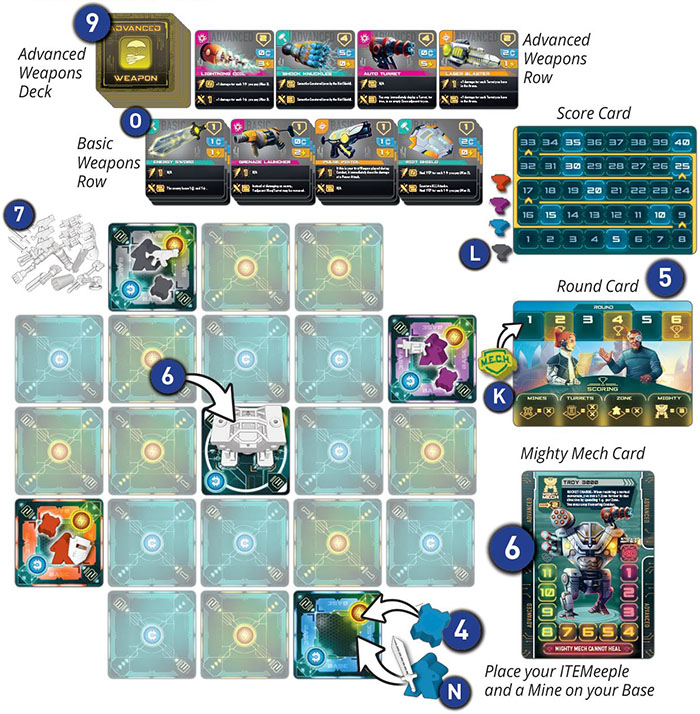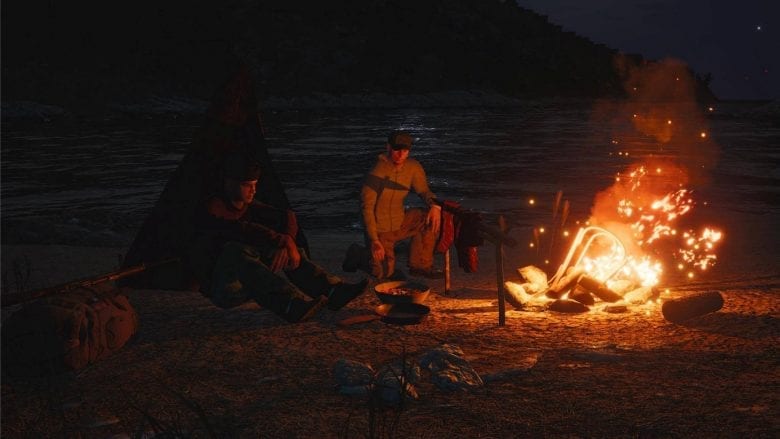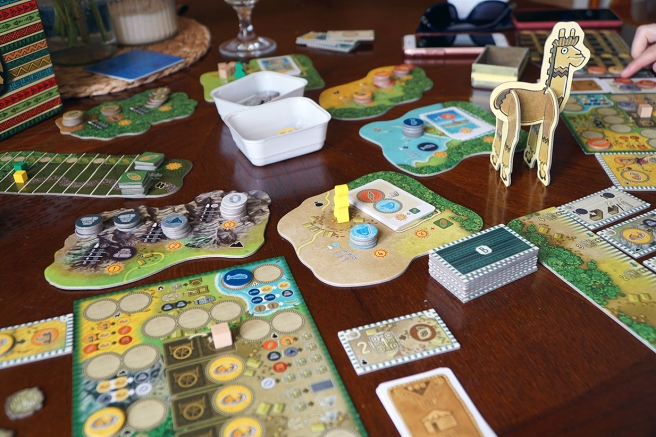Why You Should Play Tiny Epic Mechs
Aside from the toy factor—which, really, I think it’s worth $20 even if you just gave it to your kids as toys—Tiny Epic Mechs is also a blast to play if you like programming games. I’ve always enjoyed the controlled chaos of this genre, though many of them often take a really long time and may overstay their welcome. Tiny Epic Mechs can be a little longer the first time you play as everyone’s learning the rules, but once you’re familiar with it the 30–60-minute range is about right. You may even wish you had more than just 6 rounds.
The thing about programming games, of course, is that what you plan and what you end up doing may be quite different. At the very beginning, things are pretty easy because everyone’s far apart. You know you can move around a bit and you won’t run into anyone, so things will run as programmed. But the map’s not that big, and pretty soon you’re moving to the right so you can collect resources and oh there’s somebody there already, and that’s when the battles begin. Early battles aren’t so exciting, because if you’ve each only got one weapon, at most you can trade blows and then the attacker is forced to retreat because they have no more weapons. Once you start accumulating some firepower, though, things get more interesting, as each player has to evaluate whether they’re going to survive a battle before attempting to jump into somebody’s space.
Whether the battle ends in defeat or retreat, though, one thing is certain: the program’s been disrupted, and may have cascading effects. I’ve seen games in which players battled, and then one player retreated only to find that the other player was going to move into that space on their next turn. Ideally, if you can predict where somebody’s going to be (or your turn is before theirs), you can take advantage of the jump move to leap into battle, and use the counter ability of your weapon. The downside is that if you guess wrong, you’ve just moved without getting to take any other sort of action, which seems like a bit of a waste.
Even the younger kids got in on the action. (Prototype shown) Photo: Jonathan H. Liu
There are various tactics you can take during the game—grab a few more credits and get into your power armor quickly, so you can go after the mighty mech (but don’t forget to purchase a few advanced weapons soon!). Or maybe you want to run around and set up mines and turrets, limiting other players’ movement and making your resource collection more profitable. The starting zones are pretty valuable because they’re worth 2 points and they provide both resources when you collect, so it can even be worth running over to somebody’s home, triggering their mine, and then setting up your own mine or turret there (assuming you survive the blast).
I didn’t really get into the player powers, but each character has a special ability, and there’s a variety of ability types. Magma can spend energy instead of health for the first point of damage in battle. Maverick can spend credits to use an ability again. Tank takes less damage from mines and turrets. Each pilot has a particular strength—can you figure out how to use it most effectively? The multitude of weapons available also gives you lots of different options.

Tiny Epic Mechs is GeekDad Approved!
I don’t usually play a lot of solo games, but I gave the solo mode a try just to get a feel for how it works. The 3-player map is usually not my favorite because, with a square-based map, it means that the three players aren’t all spaced out the same: the player in the center is closer to the Mighty Mech and farther from the other players, which may be a slight advantage. For solo mode, however, that gets balanced out a little because the robots start with power armor and an extra weapon.
The game had a bit of the same feel: figuring out where I wanted to go, getting disrupted by a robot who marched into my space, cringing because I knew I was going to run out of weapons in a battle. But because the robots are a bit mindless, it also meant that they sometimes took suboptimal moves, like using “collect” even when they had already maxed out their resources instead of attempting to place turrets and mines. The one advantage they do have is that their “jump” actions can allow them to move any distance if they can reach you, but if you manage to escape combat, they’re not as good at pursuing you. There’s also not any sort of difficulty setting on the robots, so you can’t make them harder or easier. I generally prefer playing against human players, and I think that will still be the case for Tiny Epic Mechs.
To subscribe to GeekDad’s tabletop gaming coverage, please copy this link and add it to your RSS reader.
Disclosure: GeekDad received a copy of this game for review purposes.
Tiny Epic Mechs Components
Here’s what’s included in the game:
- 8 Pilot cards (photo includes 2 extra pilots from the Deluxe edition)
- 1 Mighty Mech card
- Score card
- Round Tracker card
- 4 Player cards
- 36 Programming decks (8 Programming cards and 1 Ad Hoc Mode card per player)
- 16 Basic Weapon cards (with plastic miniatures)
- 16 Advanced Weapon cards (with plastic miniatures)
- 21 Zone cards
- 4 sets of player components:
- ITEMeeple
- Power Armor
- 4 Mines
- 3 Turrets
- Health tracker
- Credits tracker
- Energy tracker
- Score marker
- First Player marker
- Round marker
- Mighty Mech
The box is filled to the brim with components. Photo: Jonathan H. Liu
All of this, as usual, fits into a standard Tiny Epic box, which is a compact 7″ x 4.75″. I’m always impressed by how much Gamelyn Games manages to pack into these boxes, and it’s one of the big draws for me, because there’s a lot of gameplay in a portable size at an affordable price. The Deluxe edition adds in a couple more pilot cards and the two mini expansions (which I’ll get to at the end of the How to Play section).
 Two meeples in power armor face off. (Prototype shown) Photo: Jonathan H. Liu
Two meeples in power armor face off. (Prototype shown) Photo: Jonathan H. Liu
The highlight of the components in Tiny Epic Mechs is, of course, those awesome ITEMeeples, which were first created for Tiny Epic Quest and have now been appearing in many of the Tiny Epic series since then. In TEQ, you controlled three meeples of the same color, so you needed a way to keep track of which meeple had which equipment, and the ITEMeeples were a great way to do that, and have your meeples holding little tiny weapons and items. In the other games (including Tiny Epic Mechs), they aren’t strictly necessary because you only have one meeple, so the cards in front of you indicate what you’re carrying. However, there’s no denying that the snap-on meeple armor and mech are a lot of fun. It does make it easier to tell at a glance what everyone is carrying, though until you’re familiar with the game you’ll still need to refer to the card to know what all the equipment does.
Tiny Epic Mechs basic weapons. Photo: Jonathan H. Liu
There are a lot of cards involved: the pilot and player cards are all oversized cards, with lots of information and little tokens used to track things like health, credits, and power. The weapon cards and program cards are square. Weapon cards all have illustrations that look like they’d fit in a videogame, and the gameplay and theme certainly do draw from first-person shooters, particularly the sort that involve arena matches where players respawn when they’re eliminated.
Maverick with and without his power suit. Photo: Jonathan H. Liu
The pilot cards are fun—there’s a mix of different characters and abilities. One side shows the pilot, and the other shows the same character decked out in their power armor. Although the actual meeple power armors are all identical, the illustrations let you imagine your character in their unique armor. There are sometimes weapons pictured on both the pilot and armor sides, though the actual weapons you’ll equip will depend on which cards you have.
Here’s the purple player, set up and ready to go with one basic weapon equipped. Photo: Jonathan H. Liu
The final version has red, blue, purple, and black/grey for the player colors, which should be better for color blind players than the often-used red, green, blue, and yellow. As you can see, the stretch goals unlocked during the Kickstarter campaign unlocked various shaped wooden tokens for the turrets, mines, and trackers. The score tracker (not pictured here) looks like a little trophy, with a “40+” printed on one side in case you wrap the scoreboard. All of the tokens, as with other titles in the Tiny Epic series, are quite tiny—they’re cute, but you also have to be careful not to bump your cards or you may lose track of how much money, energy, or health you have.
The round tracker card also provides a reminder about scoring. Photo: Jonathan H. Liu
The round tracker card shows the two “hosts” of the mech battle show. The top has the round track with trophy icons on the even-numbered rounds for scoring, and the bottom has reminders about how you score. The round tracker token is now a wooden shield with “M.E.C.H.” printed on it, and the first player token is a small wooden ticket that says “Admit One.”
Aside from the custom wooden components and the player colors, most of the components look pretty much like they did in the prototype, since most of the artwork was already finalized at that point. The power armors are now colored to match the player colors rather than being grey. The cards are a nice quality with a linen finish, and the colors are a little more vibrant than the prototype, but otherwise the prototype did a great job of showing what the final game would be like.
Setup

1 Give each player a Player Card and ITEMeeple of their chosen color. Then, to set up each player’s area, give each player:
A Two Pilot Cards, shuffled and dealt randomly from under the table. The player chooses one Pilot Card and places it Pilot-side up below the Player Card.
B a Health Token in their player color, placed on the highest space of their Pilot Card Health Track.
C both an Energy Token and a Credits Token in their player color, placed on the “3” space of the Player Card’s Resource Track.
D a Score Token in their player color.
E a Power Armor Item in their player color.
F 3 Turret Tokens and 4 Mine Tokens in their player color.
G 8 Program Cards and 1 Ad Hoc Mode Card in their player color.
2 Gather all 21 Zone Cards to set up the Arena:
H Separate the 21 Zone Cards into 3 types: 1 Mech Card (), 4 Base Cards (), and 16 Resource Cards ().
I Give each player a Base Card matching their player color to be placed later.
J Based on the number of players, arrange the Arena according to the diagrams below. For the Resource Cards (), shuffle and place them randomly in their designated spaces. Leave spaces open for the Base Cards ().

3 Use any method to determine which player is the Starting Player and give that player the Starting Token. Then, starting with the player to the right of the Starting Player and continuing in counter-clockwise order, each player chooses on which empty space ( b ) to place their Base Zone Card and their ITEMeeple. The Starting Player places last.
4 Each player secretly chooses one of their Mines, numbered 1-4, and places it face-down on their Base Card. The unused Mine Tokens should be kept number side face-down.
5 Place the Round Card and the Score Card within reach of all players.
K Place the Round Token on the “1” space of the Round Card.
L Place each player’s Score Token off of the Score Card next to (but not on) the “1” space. Make sure that the blank side is face-up and not the “+40” side.
6 Place the Mighty Mech on the Mech Zone Card in the center of the Arena and the two-sided Mighty Mech Card within reach of all players. Whenever a player enters the Mighty Mech, they choose which side (Troy 3000 or Sparta 3000) to use. It remains on that side until they exit the Mighty Mech.
7 Place all 32 Weapon Items in a pile within reach of all players.
8 Separate the Weapon Cards based on their card backs: 16 Basic and 16 Advanced Cards. Gather the Basic Cards and:
M Give each player the 4 Basic Weapon Cards: 1 Energy Sword, 1 Pulse Pistol, 1 Grenade Launcher, and 1 Riot Shield. Place any undealt Basic Cards into the game box, removing them from the game.
N All players secretly select 1 Basic Weapon Card to keep. After all players have done this, each player announces the card they chose and takes the matching Weapon Item, equipping the item to their ITEMeeple. Each player places the card face-up in one of the Basic Weapon slots on their Pilot Card.
O Collect the remaining unchosen Basic Weapon Cards and make piles of matching Weapons face-up, placing them in reach of all players.
9 Shuffle the Advanced Weapon Cards into a Weapons Deck, placing the deck face-down and revealing the top 4 cards face-up in a row.

Round End
After all players have resolved all four turns, the Round ends. If it is the end of Round 2, 4, or 6, then all players score for Zones they control and for the Mighty Mech (see below). If it is not the end of the 6th and final Round, do the following steps to get ready for the next Round:
Advance the Round Token to the next space on the Round track.
Pass the Starting Token to the next clockwise player. They are the next Starting Player.
All players pick up their Program Cards or Ad Hoc Mode Cards and start the Program Phase of the next Round. Any player in Ad Hoc Mode from the previous Round is no longer in Ad Hoc Mode.
Scoring Rounds
Players will score victory points for the Zones they control, and also if they control the Mighty Mech:
Mines: each score equal to each Zone’s value.
Turrets: each score equal to double each Zone’s value.
Pilot: scores equal to its Zone’s value, even if also in the same Zone as a Mine or a Turret.
If controlling the Mighty Mech: Score .
Game Play
The game takes place over 6 rounds. Each round, players will program their Pilot using Program Cards, and then execute that program to move their Pilots around the arena and perform actions. If a player enters a Zone with an enemy Pilot, Combat ensues.
After the 2nd, 4th, and 6th rounds, players will earn victory points () for having control over Zones (with their Pilots, Turrets, and Mines) and for controlling the Mighty Mech. After the 6th and final round, players also score victory points for each Weapon they have purchased.
A round consists of the following phases in order:
Program: Players secretly and simultaneously choose 4 Program Cards and lay them out, covered by their 4 unused Program Cards, in the order they will execute them (see below).
Execution: One at a time, beginning with the Starting Player, players reveal and resolve each Program Card in order (see next page).
Scoring: (on rounds 2, 4, and 6) Players gain victory points for Zones controlled and the Mighty Mech (see Scoring, pg. 15).
Overview
In Tiny Epic Mechs, players take on the roles of highly skilled and athletic Mech pilots. They compete in a free-for-all battle royale over the span of six rounds. In each round, players program their actions and execute them in order.
These actions keep you moving around the arena while allowing you to deploy defensive turrets and explosive mines, collect resources, purchase weaponry, power up into your Power Armor and eventually take control of the Mighty Mech.
When you enter a zone with another player, combat ensues. During combat, players exchange fire, using one Weapon at a time, until one player has exhausted all their Weapons and must retreat, or one player is defeated and forced to respawn at their base.
If you time your Weapon attacks correctly, you can counter your opponent and unleash a more powerful attack to gain an edge over them.
Dealing significant damage to your opponent will wow the audience and earn you points, which will bring you closer to victory. You also score victory points every two rounds based on zones you control and control of the Mighty Mech. The player with the most victory points at the end of the game wins!
Combat
Moving into the same Zone as another player begins Combat. The player who moves into the Zone immediately scores , and that player performs the first attack.
Both players will alternate attacking with one equipped Weapon at a time until one player retreats because they have exhausted all of their Weapons, OR because a player is KO’d by losing all of their health, A player cannot voluntarily retreat.
Attacking With A Weapon
Choose one of the equipped Weapon Cards (not cards in the stockpile) and rotate the card 90 degrees on its slot. This shows that the Weapon has been used and is now “exhausted” for this Combat. Then:
Deal the attack damage listed on the card’s first line, unless dealing a Power Attack (see below), to the enemy (their Health Token is moved down on their health track).
Immediately Score Qp for each 1 damage dealt. Damage dealt in excess of an enemy’s health does not reward victory points.
Note the listed ability of the attack and resolve any effects.
Power Attacking
After a player is attacked, they may immediately unleash a more powerful attack on their turn (instead of a normal attack) if they have the correct Weapon type to do so.
The Power Attack (the second line on the Weapon Card) is triggered if it can counter the type of Weapon the enemy has just used. The three types of Weapons are: Area (), Ranged (), and Melee ().
In terms of Weapon type counters, the following applies:
Area counters Ranged. Ranged counters Melee. Melee counters Area.
Retreating From Combat
When it is your turn to attack, if you have exhausted all equipped Weapons and cannot attack, you must retreat. Combat immediately ends when you retreat, and the enemy immediately scores . Move to the closest orthogonal Zone that is not hostile (if multiple Zones like this exist, you may choose). Then the retreating player goes into Ad Hoc Mode.
Getting Ko’d
As soon as a player is reduced to 0 , they are KO’d (“Knocked Out”). The player who KO’d you immediately scores . The KO’d player then goes into Ad Hoc Mode (see pg. 15) and then depending on your status when you are KO’d:
Pilot: Restore to full health. Then, if you have less than 2 or 2 on your resource track, place the Resource Token(s) on the “2” space. You then place your Pilot onto your Base Zone. If your Base is occupied by an enemy or an enemy Mine/Turret, instead place your Pilot on the closest orthogonal Zone to your Base that is not hostile.
Power Armor: Remove your ITEMeeple from its Power Armor, flip over your Pilot Card to the “Pilot” side, and restore to full health. Your Pilot then moves to the closest orthogonal Zone that is not hostile. You may change what Weapons you have equipped at this time.
Mighty Mech: Remove your ITEMeeple from the Mighty Mech and surrender the Mighty Mech to the player who KO’d you. That player now may take control of the Mighty Mech (even if they are only Pilot status) and sets it at full health. They immediately score for entering it.
The KO’d player, now in Pilot Status, moves their Pilot to the closest orthogonal Zone that is not hostile. Change what Weapons you have equipped at this time.
In the case that a Mighty Mech is KO’d by a Mine/Turret instead of Combat, the Mech will remain standing in that Zone and the player, now in Pilot Status, moves their Pilot to the closest orthogonal Zone that is not hostile.
Combat with a mine/turret
If there is an enemy Mine or a Turret in the Zone with players in Combat:
Resolve the Mine BEFORE Combat starts (the Mine explodes first, dealing damage only to the attacker).
Resolve the Turret AFTER Combat is finished (if the Turret’s owner retreats or is KO’d, the Turret then damages the attacker).
Ad Hoc Mode
If you retreat or are KO’d in Combat, you immediately go into Ad Hoc Mode:
Pick up all played Program Cards, both face-up and face-down, and place them in your stockpile.
Place the Ad Hoc Mode Card into your Program Area.
While in Ad Hoc Mode, for the remainder of the Round you can choose any Program Card and perform its movement and action for your turn. On subsequent turns, you may even use a Program Card you already used earlier in the Round.






